Environmental Analysis: Nappies' Impact and Sustainable Alternatives
VerifiedAdded on 2021/02/20
|12
|1370
|21
Report
AI Summary
This report delves into the environmental impact of nappy usage, a critical issue given the substantial waste generated daily. The study begins by presenting the problem statement, highlighting the vast quantities of disposable nappies discarded and the environmental consequences of their production and disposal, including land and water pollution, and greenhouse gas emissions. It then poses research questions to analyze the impact of different nappy types (disposable vs. reusable) and identify strategies for minimizing environmental harm. The methodology involves a qualitative approach using secondary data from environmental agencies, journals, and articles, ensuring the relevance of sources. The report assesses the environmental impact of disposable and cloth nappies, considering manufacturing processes, waste management, and the consumption of natural resources. It also examines the limitations of the available data and the need for a balanced perspective that evaluates the pros and cons of different nappy types to foster sustainable choices. The report identifies and reviews several articles to understand the environmental concerns associated with nappies and suggests strategies for reducing the negative impacts.
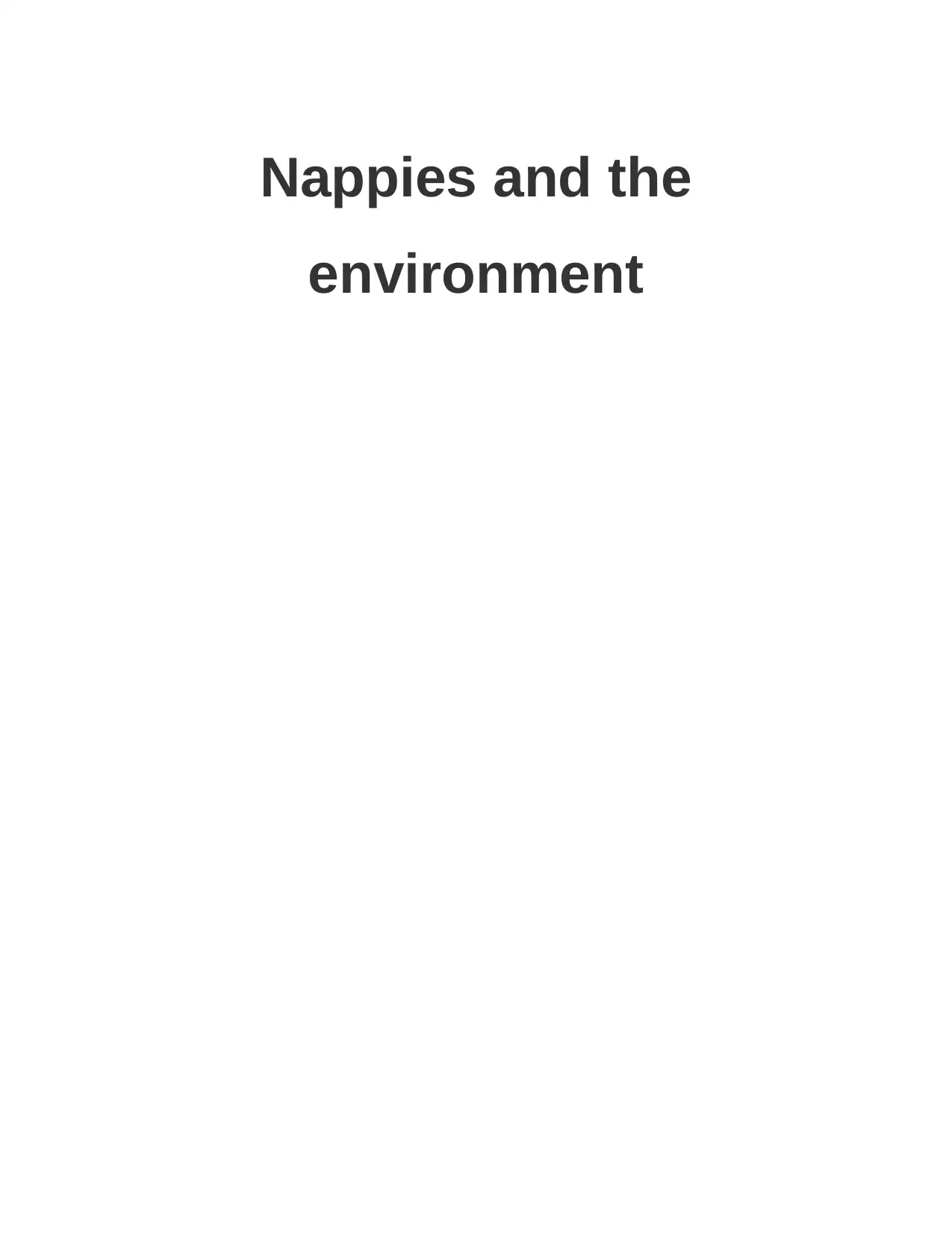
Nappies and the
environment
environment
Paraphrase This Document
Need a fresh take? Get an instant paraphrase of this document with our AI Paraphraser
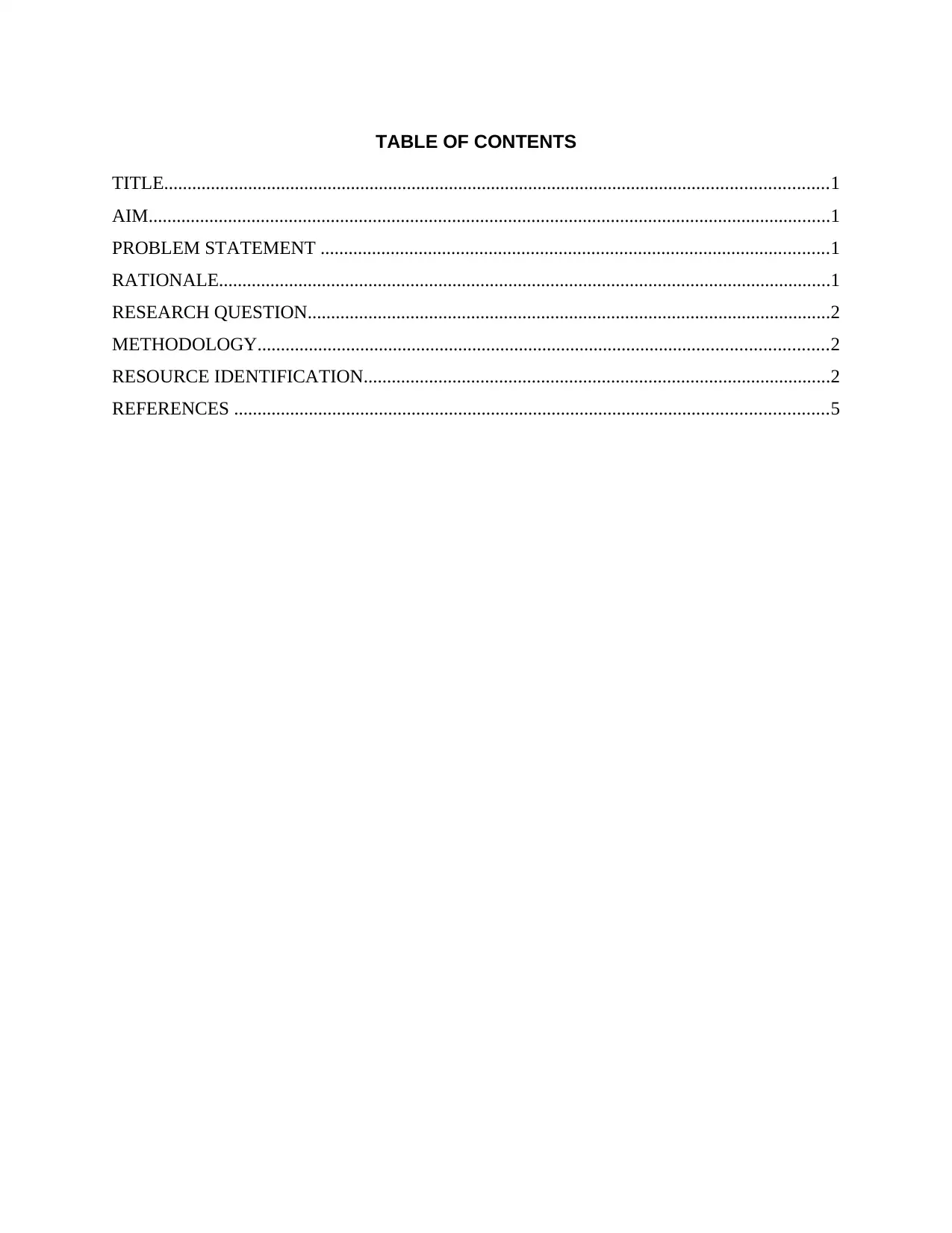
TABLE OF CONTENTS
TITLE..............................................................................................................................................1
AIM..................................................................................................................................................1
PROBLEM STATEMENT .............................................................................................................1
RATIONALE...................................................................................................................................1
RESEARCH QUESTION................................................................................................................2
METHODOLOGY..........................................................................................................................2
RESOURCE IDENTIFICATION....................................................................................................2
REFERENCES ...............................................................................................................................5
TITLE..............................................................................................................................................1
AIM..................................................................................................................................................1
PROBLEM STATEMENT .............................................................................................................1
RATIONALE...................................................................................................................................1
RESEARCH QUESTION................................................................................................................2
METHODOLOGY..........................................................................................................................2
RESOURCE IDENTIFICATION....................................................................................................2
REFERENCES ...............................................................................................................................5
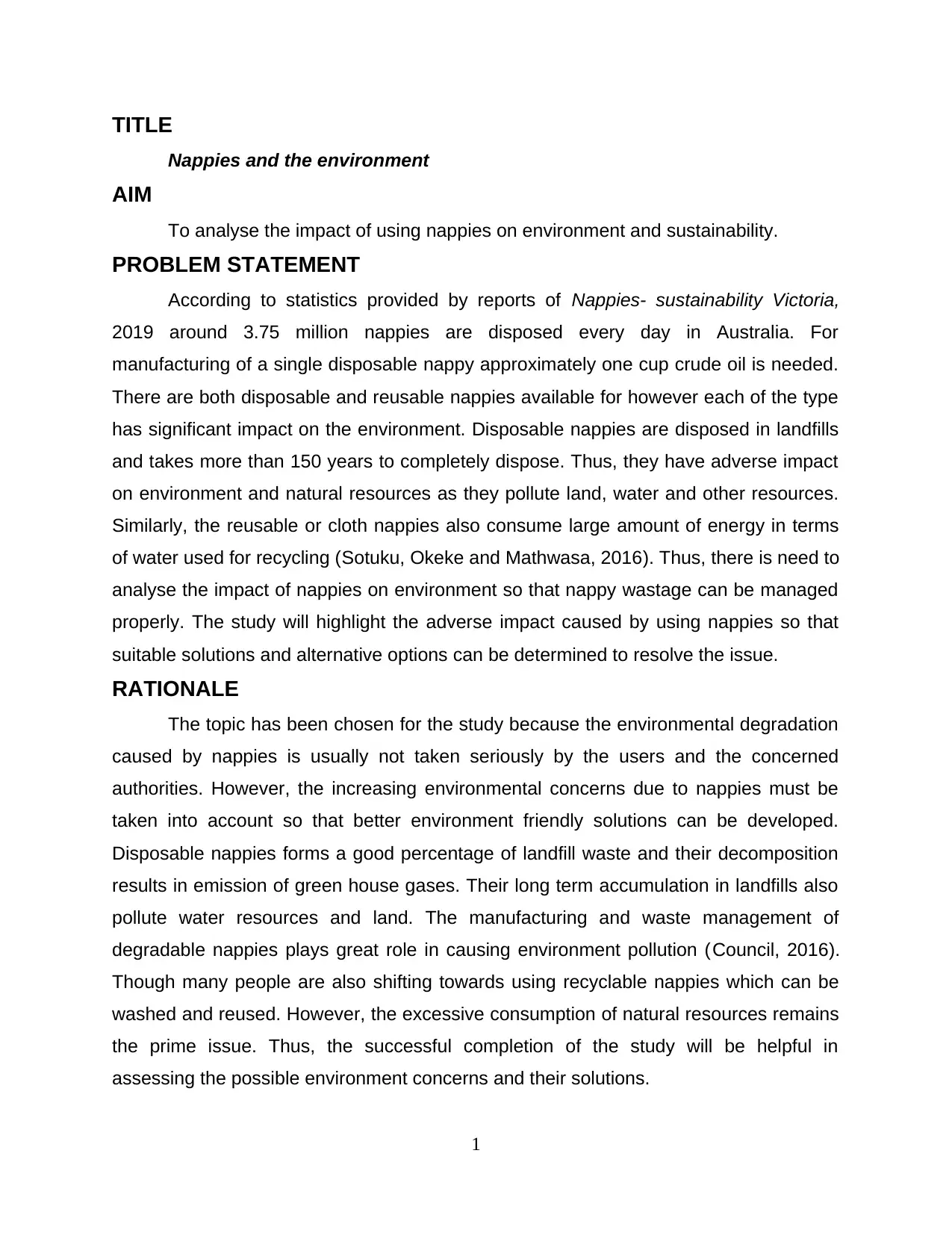
TITLE
Nappies and the environment
AIM
To analyse the impact of using nappies on environment and sustainability.
PROBLEM STATEMENT
According to statistics provided by reports of Nappies- sustainability Victoria,
2019 around 3.75 million nappies are disposed every day in Australia. For
manufacturing of a single disposable nappy approximately one cup crude oil is needed.
There are both disposable and reusable nappies available for however each of the type
has significant impact on the environment. Disposable nappies are disposed in landfills
and takes more than 150 years to completely dispose. Thus, they have adverse impact
on environment and natural resources as they pollute land, water and other resources.
Similarly, the reusable or cloth nappies also consume large amount of energy in terms
of water used for recycling (Sotuku, Okeke and Mathwasa, 2016). Thus, there is need to
analyse the impact of nappies on environment so that nappy wastage can be managed
properly. The study will highlight the adverse impact caused by using nappies so that
suitable solutions and alternative options can be determined to resolve the issue.
RATIONALE
The topic has been chosen for the study because the environmental degradation
caused by nappies is usually not taken seriously by the users and the concerned
authorities. However, the increasing environmental concerns due to nappies must be
taken into account so that better environment friendly solutions can be developed.
Disposable nappies forms a good percentage of landfill waste and their decomposition
results in emission of green house gases. Their long term accumulation in landfills also
pollute water resources and land. The manufacturing and waste management of
degradable nappies plays great role in causing environment pollution (Council, 2016).
Though many people are also shifting towards using recyclable nappies which can be
washed and reused. However, the excessive consumption of natural resources remains
the prime issue. Thus, the successful completion of the study will be helpful in
assessing the possible environment concerns and their solutions.
1
Nappies and the environment
AIM
To analyse the impact of using nappies on environment and sustainability.
PROBLEM STATEMENT
According to statistics provided by reports of Nappies- sustainability Victoria,
2019 around 3.75 million nappies are disposed every day in Australia. For
manufacturing of a single disposable nappy approximately one cup crude oil is needed.
There are both disposable and reusable nappies available for however each of the type
has significant impact on the environment. Disposable nappies are disposed in landfills
and takes more than 150 years to completely dispose. Thus, they have adverse impact
on environment and natural resources as they pollute land, water and other resources.
Similarly, the reusable or cloth nappies also consume large amount of energy in terms
of water used for recycling (Sotuku, Okeke and Mathwasa, 2016). Thus, there is need to
analyse the impact of nappies on environment so that nappy wastage can be managed
properly. The study will highlight the adverse impact caused by using nappies so that
suitable solutions and alternative options can be determined to resolve the issue.
RATIONALE
The topic has been chosen for the study because the environmental degradation
caused by nappies is usually not taken seriously by the users and the concerned
authorities. However, the increasing environmental concerns due to nappies must be
taken into account so that better environment friendly solutions can be developed.
Disposable nappies forms a good percentage of landfill waste and their decomposition
results in emission of green house gases. Their long term accumulation in landfills also
pollute water resources and land. The manufacturing and waste management of
degradable nappies plays great role in causing environment pollution (Council, 2016).
Though many people are also shifting towards using recyclable nappies which can be
washed and reused. However, the excessive consumption of natural resources remains
the prime issue. Thus, the successful completion of the study will be helpful in
assessing the possible environment concerns and their solutions.
1
⊘ This is a preview!⊘
Do you want full access?
Subscribe today to unlock all pages.

Trusted by 1+ million students worldwide
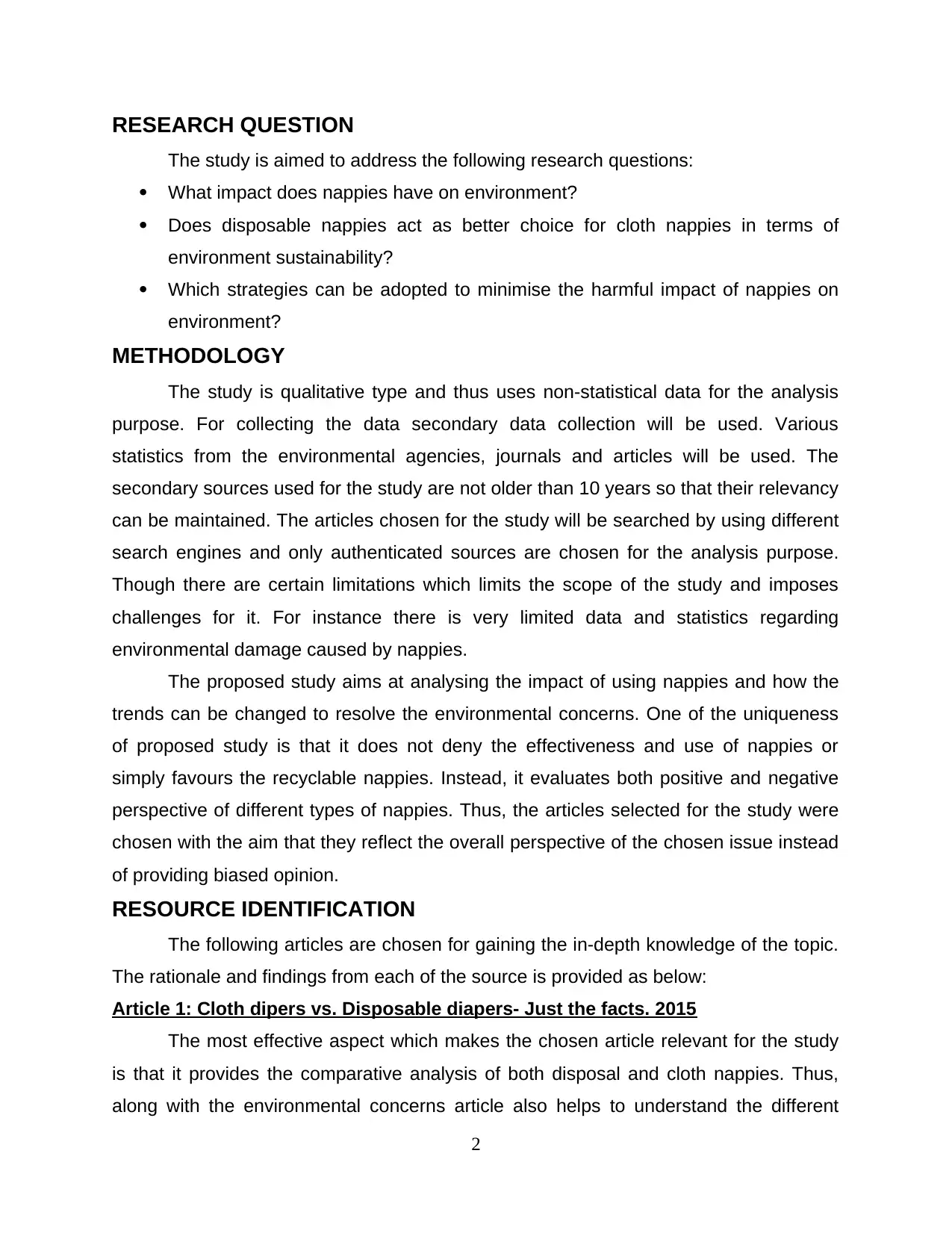
RESEARCH QUESTION
The study is aimed to address the following research questions:
What impact does nappies have on environment?
Does disposable nappies act as better choice for cloth nappies in terms of
environment sustainability?
Which strategies can be adopted to minimise the harmful impact of nappies on
environment?
METHODOLOGY
The study is qualitative type and thus uses non-statistical data for the analysis
purpose. For collecting the data secondary data collection will be used. Various
statistics from the environmental agencies, journals and articles will be used. The
secondary sources used for the study are not older than 10 years so that their relevancy
can be maintained. The articles chosen for the study will be searched by using different
search engines and only authenticated sources are chosen for the analysis purpose.
Though there are certain limitations which limits the scope of the study and imposes
challenges for it. For instance there is very limited data and statistics regarding
environmental damage caused by nappies.
The proposed study aims at analysing the impact of using nappies and how the
trends can be changed to resolve the environmental concerns. One of the uniqueness
of proposed study is that it does not deny the effectiveness and use of nappies or
simply favours the recyclable nappies. Instead, it evaluates both positive and negative
perspective of different types of nappies. Thus, the articles selected for the study were
chosen with the aim that they reflect the overall perspective of the chosen issue instead
of providing biased opinion.
RESOURCE IDENTIFICATION
The following articles are chosen for gaining the in-depth knowledge of the topic.
The rationale and findings from each of the source is provided as below:
Article 1: Cloth dipers vs. Disposable diapers- Just the facts. 2015
The most effective aspect which makes the chosen article relevant for the study
is that it provides the comparative analysis of both disposal and cloth nappies. Thus,
along with the environmental concerns article also helps to understand the different
2
The study is aimed to address the following research questions:
What impact does nappies have on environment?
Does disposable nappies act as better choice for cloth nappies in terms of
environment sustainability?
Which strategies can be adopted to minimise the harmful impact of nappies on
environment?
METHODOLOGY
The study is qualitative type and thus uses non-statistical data for the analysis
purpose. For collecting the data secondary data collection will be used. Various
statistics from the environmental agencies, journals and articles will be used. The
secondary sources used for the study are not older than 10 years so that their relevancy
can be maintained. The articles chosen for the study will be searched by using different
search engines and only authenticated sources are chosen for the analysis purpose.
Though there are certain limitations which limits the scope of the study and imposes
challenges for it. For instance there is very limited data and statistics regarding
environmental damage caused by nappies.
The proposed study aims at analysing the impact of using nappies and how the
trends can be changed to resolve the environmental concerns. One of the uniqueness
of proposed study is that it does not deny the effectiveness and use of nappies or
simply favours the recyclable nappies. Instead, it evaluates both positive and negative
perspective of different types of nappies. Thus, the articles selected for the study were
chosen with the aim that they reflect the overall perspective of the chosen issue instead
of providing biased opinion.
RESOURCE IDENTIFICATION
The following articles are chosen for gaining the in-depth knowledge of the topic.
The rationale and findings from each of the source is provided as below:
Article 1: Cloth dipers vs. Disposable diapers- Just the facts. 2015
The most effective aspect which makes the chosen article relevant for the study
is that it provides the comparative analysis of both disposal and cloth nappies. Thus,
along with the environmental concerns article also helps to understand the different
2
Paraphrase This Document
Need a fresh take? Get an instant paraphrase of this document with our AI Paraphraser
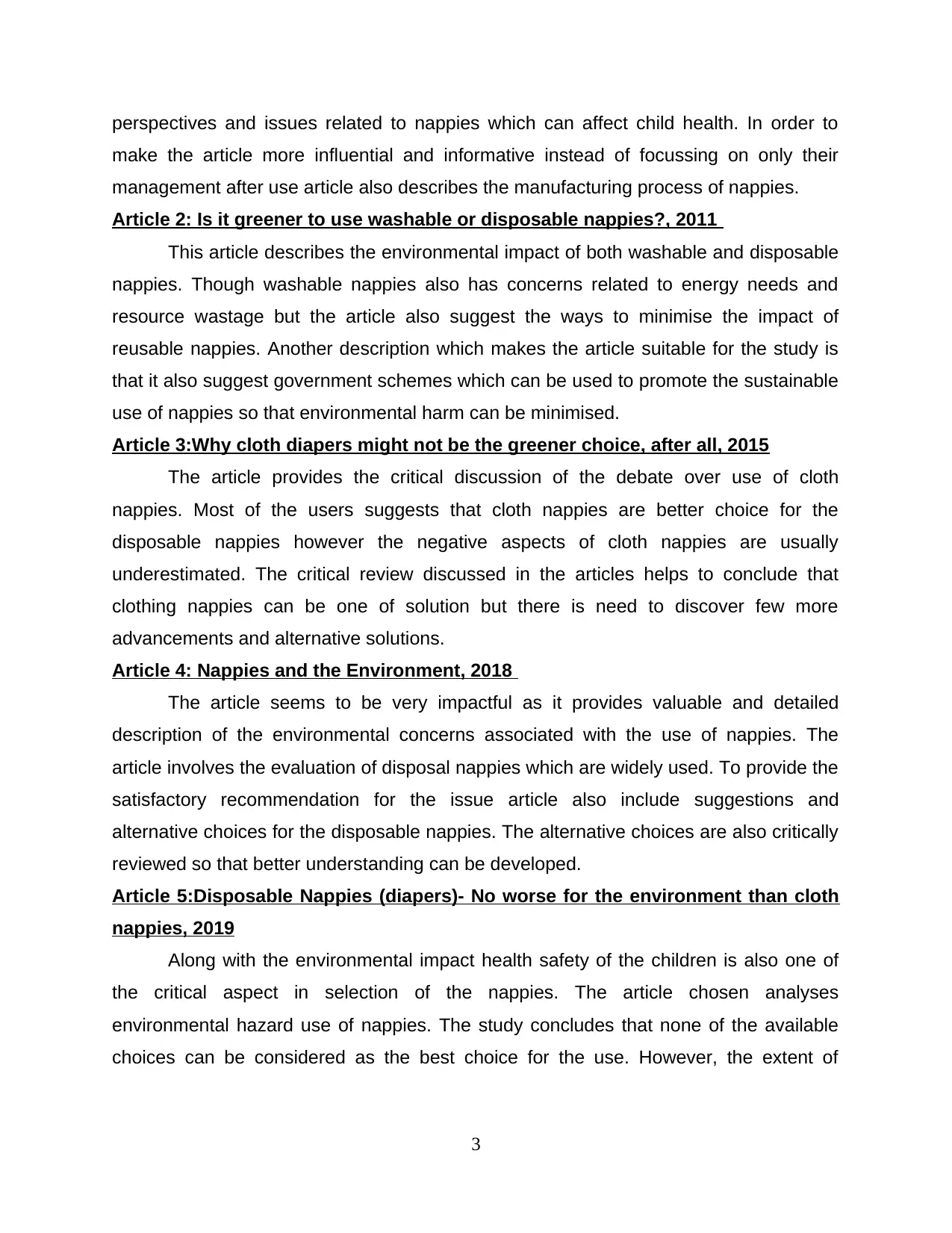
perspectives and issues related to nappies which can affect child health. In order to
make the article more influential and informative instead of focussing on only their
management after use article also describes the manufacturing process of nappies.
Article 2: Is it greener to use washable or disposable nappies?, 2011
This article describes the environmental impact of both washable and disposable
nappies. Though washable nappies also has concerns related to energy needs and
resource wastage but the article also suggest the ways to minimise the impact of
reusable nappies. Another description which makes the article suitable for the study is
that it also suggest government schemes which can be used to promote the sustainable
use of nappies so that environmental harm can be minimised.
Article 3:Why cloth diapers might not be the greener choice, after all, 2015
The article provides the critical discussion of the debate over use of cloth
nappies. Most of the users suggests that cloth nappies are better choice for the
disposable nappies however the negative aspects of cloth nappies are usually
underestimated. The critical review discussed in the articles helps to conclude that
clothing nappies can be one of solution but there is need to discover few more
advancements and alternative solutions.
Article 4: Nappies and the Environment, 2018
The article seems to be very impactful as it provides valuable and detailed
description of the environmental concerns associated with the use of nappies. The
article involves the evaluation of disposal nappies which are widely used. To provide the
satisfactory recommendation for the issue article also include suggestions and
alternative choices for the disposable nappies. The alternative choices are also critically
reviewed so that better understanding can be developed.
Article 5:Disposable Nappies (diapers)- No worse for the environment than cloth
nappies, 2019
Along with the environmental impact health safety of the children is also one of
the critical aspect in selection of the nappies. The article chosen analyses
environmental hazard use of nappies. The study concludes that none of the available
choices can be considered as the best choice for the use. However, the extent of
3
make the article more influential and informative instead of focussing on only their
management after use article also describes the manufacturing process of nappies.
Article 2: Is it greener to use washable or disposable nappies?, 2011
This article describes the environmental impact of both washable and disposable
nappies. Though washable nappies also has concerns related to energy needs and
resource wastage but the article also suggest the ways to minimise the impact of
reusable nappies. Another description which makes the article suitable for the study is
that it also suggest government schemes which can be used to promote the sustainable
use of nappies so that environmental harm can be minimised.
Article 3:Why cloth diapers might not be the greener choice, after all, 2015
The article provides the critical discussion of the debate over use of cloth
nappies. Most of the users suggests that cloth nappies are better choice for the
disposable nappies however the negative aspects of cloth nappies are usually
underestimated. The critical review discussed in the articles helps to conclude that
clothing nappies can be one of solution but there is need to discover few more
advancements and alternative solutions.
Article 4: Nappies and the Environment, 2018
The article seems to be very impactful as it provides valuable and detailed
description of the environmental concerns associated with the use of nappies. The
article involves the evaluation of disposal nappies which are widely used. To provide the
satisfactory recommendation for the issue article also include suggestions and
alternative choices for the disposable nappies. The alternative choices are also critically
reviewed so that better understanding can be developed.
Article 5:Disposable Nappies (diapers)- No worse for the environment than cloth
nappies, 2019
Along with the environmental impact health safety of the children is also one of
the critical aspect in selection of the nappies. The article chosen analyses
environmental hazard use of nappies. The study concludes that none of the available
choices can be considered as the best choice for the use. However, the extent of
3
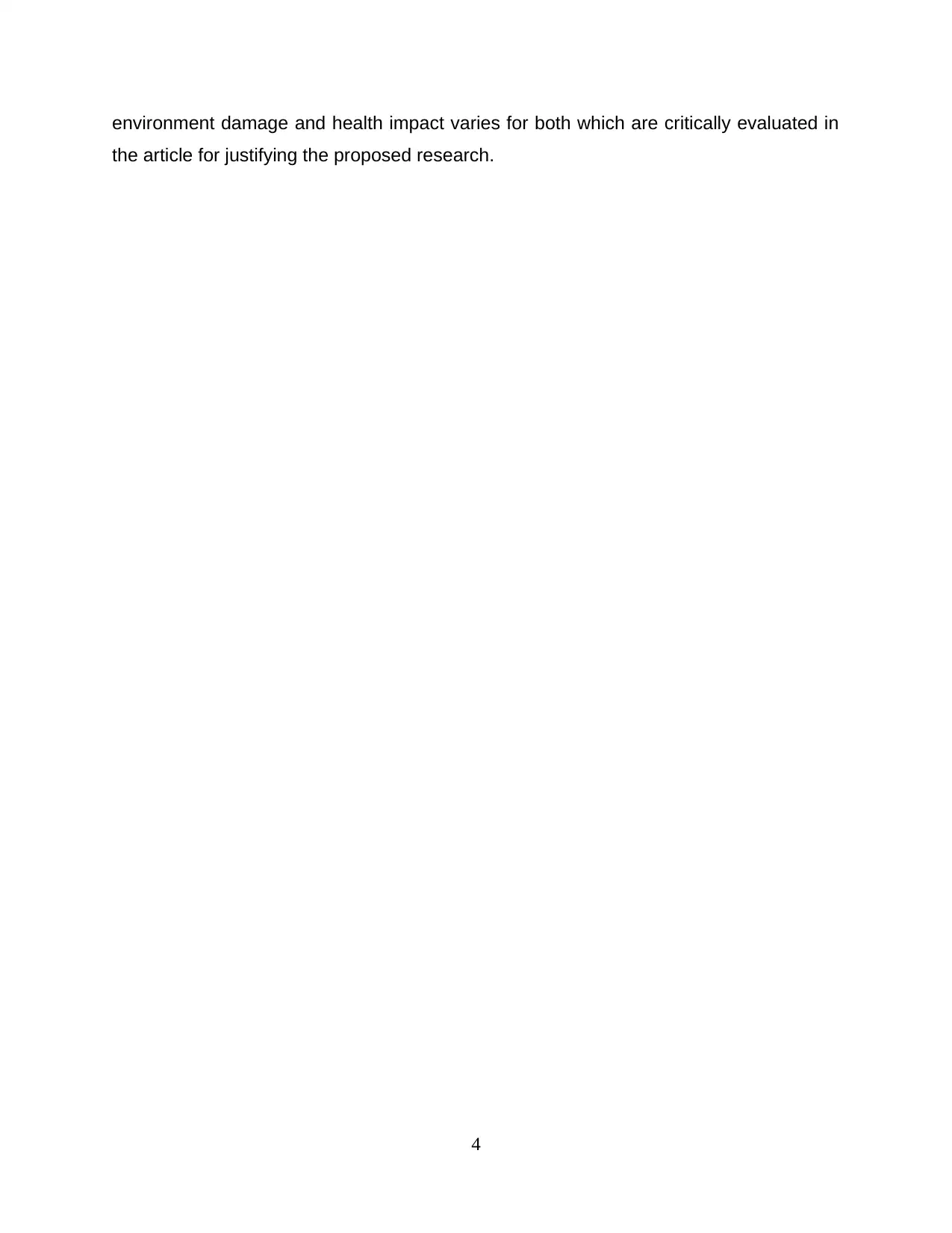
environment damage and health impact varies for both which are critically evaluated in
the article for justifying the proposed research.
4
the article for justifying the proposed research.
4
⊘ This is a preview!⊘
Do you want full access?
Subscribe today to unlock all pages.

Trusted by 1+ million students worldwide
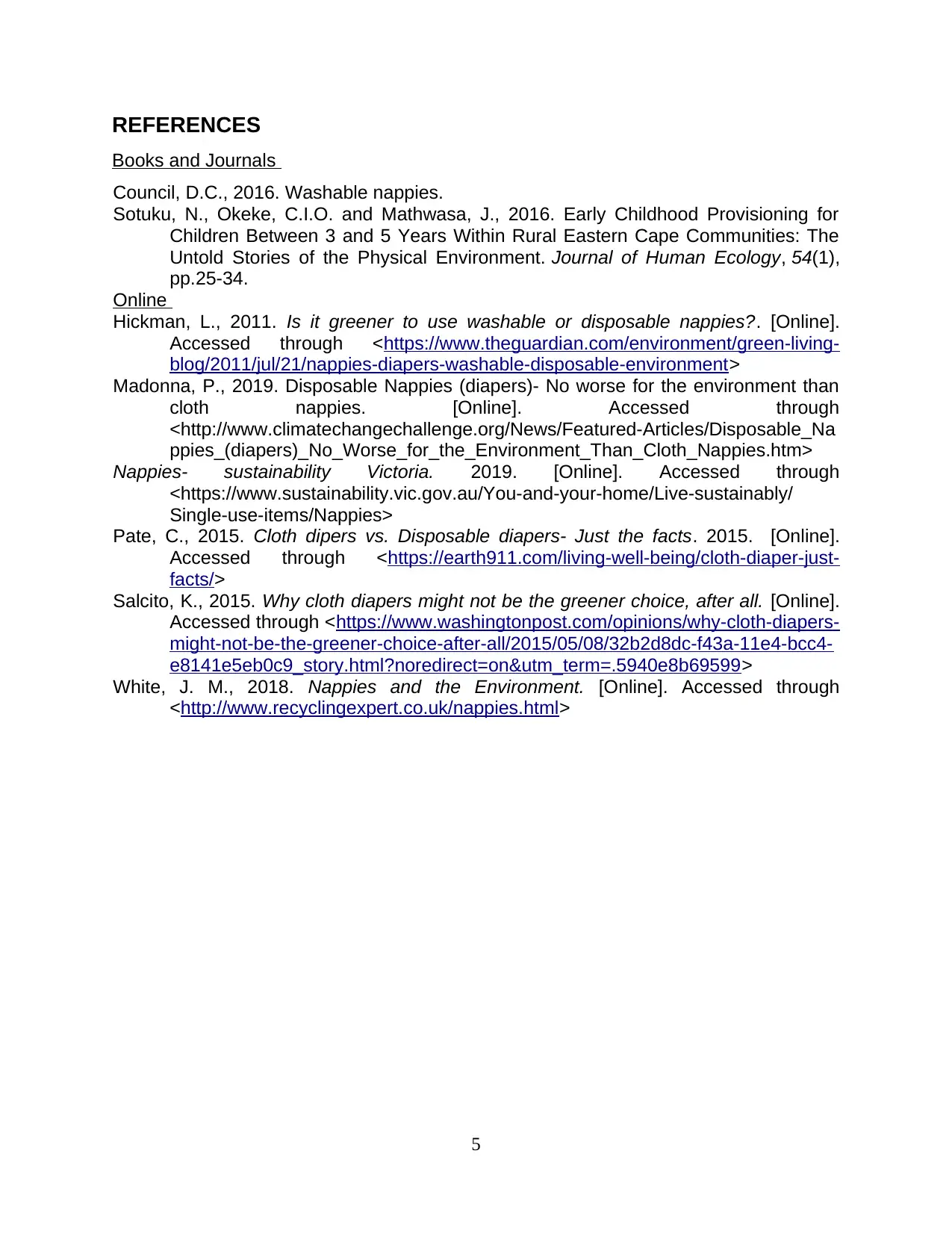
REFERENCES
Books and Journals
Council, D.C., 2016. Washable nappies.
Sotuku, N., Okeke, C.I.O. and Mathwasa, J., 2016. Early Childhood Provisioning for
Children Between 3 and 5 Years Within Rural Eastern Cape Communities: The
Untold Stories of the Physical Environment. Journal of Human Ecology, 54(1),
pp.25-34.
Online
Hickman, L., 2011. Is it greener to use washable or disposable nappies?. [Online].
Accessed through <https://www.theguardian.com/environment/green-living-
blog/2011/jul/21/nappies-diapers-washable-disposable-environment>
Madonna, P., 2019. Disposable Nappies (diapers)- No worse for the environment than
cloth nappies. [Online]. Accessed through
<http://www.climatechangechallenge.org/News/Featured-Articles/Disposable_Na
ppies_(diapers)_No_Worse_for_the_Environment_Than_Cloth_Nappies.htm>
Nappies- sustainability Victoria. 2019. [Online]. Accessed through
<https://www.sustainability.vic.gov.au/You-and-your-home/Live-sustainably/
Single-use-items/Nappies>
Pate, C., 2015. Cloth dipers vs. Disposable diapers- Just the facts. 2015. [Online].
Accessed through <https://earth911.com/living-well-being/cloth-diaper-just-
facts/>
Salcito, K., 2015. Why cloth diapers might not be the greener choice, after all. [Online].
Accessed through <https://www.washingtonpost.com/opinions/why-cloth-diapers-
might-not-be-the-greener-choice-after-all/2015/05/08/32b2d8dc-f43a-11e4-bcc4-
e8141e5eb0c9_story.html?noredirect=on&utm_term=.5940e8b69599>
White, J. M., 2018. Nappies and the Environment. [Online]. Accessed through
<http://www.recyclingexpert.co.uk/nappies.html>
5
Books and Journals
Council, D.C., 2016. Washable nappies.
Sotuku, N., Okeke, C.I.O. and Mathwasa, J., 2016. Early Childhood Provisioning for
Children Between 3 and 5 Years Within Rural Eastern Cape Communities: The
Untold Stories of the Physical Environment. Journal of Human Ecology, 54(1),
pp.25-34.
Online
Hickman, L., 2011. Is it greener to use washable or disposable nappies?. [Online].
Accessed through <https://www.theguardian.com/environment/green-living-
blog/2011/jul/21/nappies-diapers-washable-disposable-environment>
Madonna, P., 2019. Disposable Nappies (diapers)- No worse for the environment than
cloth nappies. [Online]. Accessed through
<http://www.climatechangechallenge.org/News/Featured-Articles/Disposable_Na
ppies_(diapers)_No_Worse_for_the_Environment_Than_Cloth_Nappies.htm>
Nappies- sustainability Victoria. 2019. [Online]. Accessed through
<https://www.sustainability.vic.gov.au/You-and-your-home/Live-sustainably/
Single-use-items/Nappies>
Pate, C., 2015. Cloth dipers vs. Disposable diapers- Just the facts. 2015. [Online].
Accessed through <https://earth911.com/living-well-being/cloth-diaper-just-
facts/>
Salcito, K., 2015. Why cloth diapers might not be the greener choice, after all. [Online].
Accessed through <https://www.washingtonpost.com/opinions/why-cloth-diapers-
might-not-be-the-greener-choice-after-all/2015/05/08/32b2d8dc-f43a-11e4-bcc4-
e8141e5eb0c9_story.html?noredirect=on&utm_term=.5940e8b69599>
White, J. M., 2018. Nappies and the Environment. [Online]. Accessed through
<http://www.recyclingexpert.co.uk/nappies.html>
5
Paraphrase This Document
Need a fresh take? Get an instant paraphrase of this document with our AI Paraphraser

6

7
⊘ This is a preview!⊘
Do you want full access?
Subscribe today to unlock all pages.

Trusted by 1+ million students worldwide

8
Paraphrase This Document
Need a fresh take? Get an instant paraphrase of this document with our AI Paraphraser

9

10
⊘ This is a preview!⊘
Do you want full access?
Subscribe today to unlock all pages.

Trusted by 1+ million students worldwide
1 out of 12
Related Documents
Your All-in-One AI-Powered Toolkit for Academic Success.
+13062052269
info@desklib.com
Available 24*7 on WhatsApp / Email
![[object Object]](/_next/static/media/star-bottom.7253800d.svg)
Unlock your academic potential
Copyright © 2020–2025 A2Z Services. All Rights Reserved. Developed and managed by ZUCOL.




